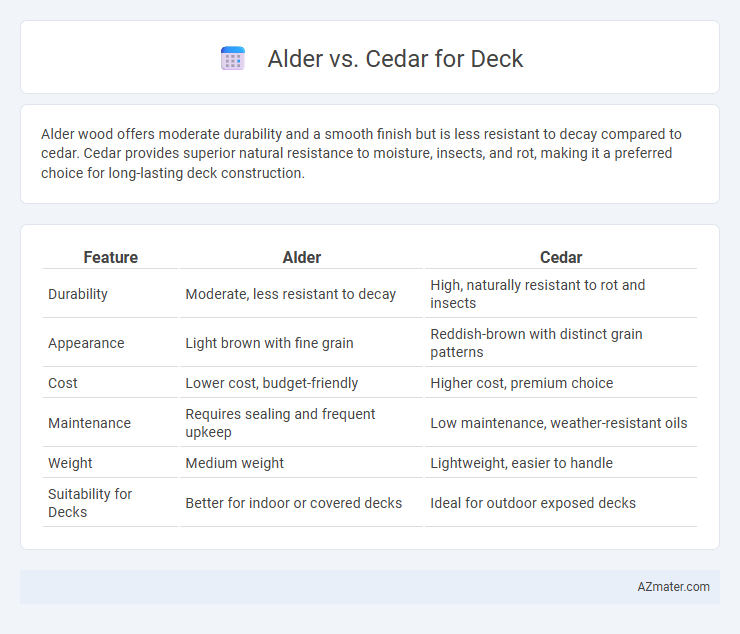Alder wood offers moderate durability and a smooth finish but is less resistant to decay compared to cedar. Cedar provides superior natural resistance to moisture, insects, and rot, making it a preferred choice for long-lasting deck construction.
Table of Comparison
| Feature | Alder | Cedar |
|---|---|---|
| Durability | Moderate, less resistant to decay | High, naturally resistant to rot and insects |
| Appearance | Light brown with fine grain | Reddish-brown with distinct grain patterns |
| Cost | Lower cost, budget-friendly | Higher cost, premium choice |
| Maintenance | Requires sealing and frequent upkeep | Low maintenance, weather-resistant oils |
| Weight | Medium weight | Lightweight, easier to handle |
| Suitability for Decks | Better for indoor or covered decks | Ideal for outdoor exposed decks |
Introduction: Comparing Alder and Cedar for Decks
Alder and cedar are popular wood choices for decks due to their natural durability and aesthetic appeal. Cedar offers superior resistance to decay and insect damage, making it ideal for outdoor use, while alder provides a smooth texture and affordability but requires treatment for weather resistance. Both woods vary in grain patterns and color, influencing maintenance needs and long-term performance in decking applications.
Wood Appearance: Alder vs Cedar
Alder wood features a smooth, fine grain with a light brown to reddish hue, offering a warm and uniform appearance ideal for modern decks. Cedar displays a more pronounced grain pattern with rich reddish tones and natural knots, adding rustic charm and character to outdoor spaces. Both woods age gracefully; alder tends to develop a deeper patina while cedar weathers to a soft gray, enhancing deck aesthetics over time.
Durability and Longevity
Cedar offers superior durability for decking due to its natural resistance to rot, decay, and insect damage, making it well-suited for outdoor exposure and harsh weather conditions. Alder, while softer and more prone to scratches and dents, has lower resistance to moisture and requires more maintenance to prevent deterioration over time. For longevity, cedar decks typically last 15-20 years or more with proper care, whereas alder decks may have a shorter lifespan unless regularly sealed and maintained.
Resistance to Rot and Insects
Alder wood exhibits moderate resistance to rot and insects, making it less durable for outdoor decking compared to cedar. Cedar naturally contains oils and phenolic compounds that provide superior resistance to rot, decay, and insect damage, extending the lifespan of decks in various climates. Choosing cedar over alder significantly improves deck longevity and reduces maintenance costs due to its enhanced protective properties.
Maintenance Requirements
Alder wood decks demand regular sealing and staining every 1-2 years to prevent moisture absorption and maintain appearance due to its softer grain and moderate decay resistance. Cedar decks benefit from natural preservatives in the wood, requiring less frequent maintenance, typically resealing every 3-4 years to protect against weather and insect damage. Both woods benefit from routine cleaning to avoid mold and mildew buildup, but cedar's natural oils provide superior resistance, reducing overall upkeep efforts.
Cost Comparison: Alder vs Cedar
Alder wood generally costs less than cedar, making it a budget-friendly option for decking projects. Cedar, while pricier, offers natural resistance to decay and insect damage, potentially reducing long-term maintenance costs. Choosing between alder and cedar often depends on balancing initial investment against durability and upkeep expenses.
Workability and Installation
Alder wood offers excellent workability due to its fine, uniform grain and softness, making it easy to cut, shape, and sand during deck installation. Cedar, while slightly softer and more flexible, provides natural resistance to decay and insects, but may require more care to prevent splintering when nailing or screwing. Both woods allow for straightforward installation, but alder's smoother surface results in faster finishing and less tool wear compared to cedar.
Environmental Impact and Sustainability
Alder wood is considered more sustainable than cedar due to its faster growth rate and potential for responsible forest management, reducing the environmental footprint of deck construction. Cedar, while naturally rot-resistant and durable, often comes from slower-growing trees, which can contribute to longer replenishment cycles and greater ecological impact if not sourced responsibly. Choosing certified sustainably harvested alder or cedar ensures reduced deforestation and supports biodiversity conservation efforts in deck building projects.
Best Uses and Design Applications
Alder wood offers a smooth, fine grain ideal for stained or painted decks that require a warm, reddish-brown finish, making it suitable for residential patios and furniture with a refined, rustic aesthetic. Cedar is prized for its natural resistance to decay and insects, making it a top choice for outdoor decks exposed to moisture and varying weather, while its aromatic qualities and knotty texture enhance cabin-style or coastal designs. Both woods provide versatile options, but cedar is often preferred for durability and maintenance ease, whereas alder excels in interior-focused designs requiring a polished, elegant look.
Conclusion: Choosing the Right Wood for Your Deck
Alder offers a smooth texture and consistent grain, making it ideal for painted or stained decks but requires regular maintenance due to its softness. Cedar provides natural resistance to rot, insects, and weather, ensuring durability and minimal upkeep, ideal for outdoor deck environments. Selecting the right wood hinges on balancing aesthetics, longevity, and maintenance needs, with cedar favored for durability and alder best suited for customizable finishes.

Infographic: Alder vs Cedar for Deck
 azmater.com
azmater.com